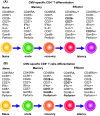The immune response to cytomegalovirus in allogeneic hematopoietic stem cell transplant recipients
- PMID: 26174234
- PMCID: PMC11113937
- DOI: 10.1007/s00018-015-1986-z
The immune response to cytomegalovirus in allogeneic hematopoietic stem cell transplant recipients
Abstract
Approximately, up to 70 % of the human population is infected with cytomegalovirus (CMV) that persists for life in a latent state. In healthy people, CMV reactivation induces the expansion of CMV-specific T cells up to 10 % of the entire T cell repertoire. On the contrary, CMV infection is a major opportunistic viral pathogen that remains a leading cause of morbidity and mortality after allogeneic hematopoietic stem cell transplantation. Due to the delayed CMV-specific immune recovery, the incidence of CMV reactivation during post-transplant period is very high. Several methods are currently available for the monitoring of CMV-specific responses that help in clinical monitoring. In this review, essential aspects in the immune recovery against CMV are discussed to improve the better understanding of the immune system relying on CMV infection and, thereby, helping the avoidance of CMV disease or reactivation following hematopoietic stem cell transplantation with severe consequences for the transplanted patients.
Keywords: Allogeneic HSCT; CMV-specific T cells; Immune monitoring.
Figures

References
Publication types
MeSH terms
Substances
LinkOut - more resources
Full Text Sources
Medical

